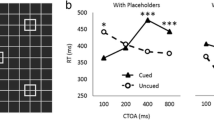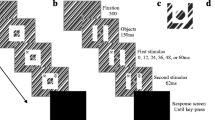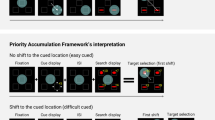Abstract
Many studies have reported that spatial attention can be involuntarily captured by salient stimuli such as abrupt onsets. These involuntary shifts are often assumed to have the same effects on feature extraction as voluntary shifts: there are two different ways of moving the same attentional mechanism. According to this unified model of spatial attention, all shifts of attention should enhance the identification of attended objects. We directly tested this assumption using compatibility effects in a series of spatial cueing experiments. Participants searched a display and indicated whether the target number was greater or less than five. The salient precues were also numbers, allowing measurement of compatibility effects between the precue and the target. Precues that reliably predicted the target location produced compatibility effects (e.g., the precue “1” facilitated responding to the target “one”), indicating enhanced identification of the precue. Compatibility effects were also found for precues that were nonpredictive but had the target-finding feature (i.e., contingent capture). Critically, however, four separate experiments failed to find compatibility effects for salient abrupt onsets that were neither predictive nor task-relevant. This is surprising given that these same precues produced enormous cue validity effects (up to 186 ms), suggesting salience-based attention capture. Our findings argue against the unified model: salience-based attention capture recruits different attentional mechanisms than contingent capture or voluntary shifts in attention.







Similar content being viewed by others
Notes
Zivony and Lamy (2018) found a correlation between cueing effects and compatibility effects for task-relevant abrupt onsets, r(57) = 0.38, p = 0.003, but not for irrelevant onsets r(57) = 0.09, p = 0.500. They therefore argued that the lack of compatibility effects for irrelevant abrupt onsets is not due merely to a scaling effect (a small location effect makes it difficult for an irrelevant onset to produce a compatibility effect).
RT and error rate analyses showed opposing trends for cue validity effects in E1. Therefore, we reanalyzed the data using inverse efficiency scores (defined as RT/(1 − error rate)) which combine RT and accuracy effects into one score. In this analysis, cue validity effects were still significantly larger for task-relevant cues than for task-irrelevant cues, t(54) = 2.01, p = 0.049, d = 0.54.
The cutoff value in Experiment 4 was adjusted upward so that the cutoff was again roughly twice the mean RT. Despite this increase, the percent of trials trimmed was higher in Experiment 4. We also ran a follow-up analysis using an even higher cutoff value (3000 ms) that eliminated a more similar percent of trials as the earlier experiments (2.0%); the key effects did not change by more than 2 ms.
References
Bacon, W. F., & Egeth, H. E. (1994). Overriding stimulus-driven attentional capture. Perception & Psychophysics, 55(5), 485–496. https://doi.org/10.3758/BF03205306.
Brainard, D. H. (1997). The psychophysics toolbox. Spatial Vision, 10(4), 433–436. https://doi.org/10.1163/156856897X00357.
Carmel, T., & Lamy, D. (2014). The same-location cost is unrelated to attentional settings: An object-updating account. Journal of Experimental Psychology: Human Perception and Performance, 40(4), 1465–1478. https://doi.org/10.1037/a0036383.
Chica, A. B., Bartolomeo, P., & Lupiáñez, J. (2013). Two cognitive and neural systems for endogenous and exogenous spatial attention. Behavioural Brain Research, 237, 107–123. https://doi.org/10.1016/j.bbr.2012.09.027.
Desimone, R., & Duncan, J. (1995). Neural mechanisms of selective visual attention. Annual Review of Neuroscience, 18(1), 193–222.
Folk, C. L., & Remington, R. (1999). Can new objects override attentional control settings? Perception & Psychophysics, 61(4), 727–739. https://doi.org/10.3758/BF03205541.
Folk, C. L., & Remington, R. (2006). Top-down modulation of preattentive processing: Testing the recovery account of contingent capture. Visual Cognition, 14(4–8), 445–465. https://doi.org/10.1080/13506280500193545.
Folk, C. L., Remington, R., & Johnston, J. C. (1992). Involuntary covert orienting is contingent on attentional control settings. Journal of Experimental Psychology: Human Perception and Performance, 18(4), 1030–1044. https://doi.org/10.1037/0096-1523.18.4.1030.
Folk, C. L., Remington, R. W., & Wu, S.-C. (2009). Additivity of abrupt onset effects supports nonspatial distraction, not the capture of spatial attention. Attention, Perception & Psychophysics, 71(2), 308–313. https://doi.org/10.3758/APP.71.2.308.
Gaspelin, N., & Luck, S. J. (2018). The Role of inhibition in avoiding distraction by salient stimuli. Trends in Cognitive Sciences, 22(1), 79–92. https://doi.org/10.1016/j.tics.2017.11.001.
Gaspelin, N., Ruthruff, E., & Lien, M. C. (2016). The problem of latent attentional capture: Easy visual search conceals capture by task irrelevant abrupt onsets. Journal of Experimental Psychology: Human Perception and Performance, 42(8), 1104–1120. https://doi.org/10.1037/xhp0000214.
Gaspelin, N., Ruthruff, E., Lien, M.-C., & Jung, K. (2012). Breaking through the attentional window: Capture by abrupt onsets versus color singletons. Attention, Perception, and Psychophysics, 74, 1461–1474.
Goller, F., Ditye, T., & Ansorge, U. (2016). The contribution of color to attention capture effects during search for onset targets. Attention, Perception, & Psychophysics, 78(3), 789–807. https://doi.org/10.3758/s13414-015-1053-8.
Jonides, J. (1981). Voluntary versus automatic control over the mind's eye's movement. In J. B. Long & A. D. Baddeley (Eds.), Attention and performance IX (pp. 187–203). Hillsdale, NJ: Erlbaum.
Lamy, D., Darnell, M., Levi, A., & Bublil, C. (2018). Testing the attentional dwelling hypothesis of attentional capture. Journal of Cognition, 1(1), 43. https://doi.org/10.5334/joc.48.
Liu, T., Abrams, J., & Carrasco, M. (2009). Voluntary attention enhances contrast appearance. Psychological Science, 20(3), 354–362. https://doi.org/10.1111/j.1467-9280.2009.02300.x.
Luck, S. J., & Vecera, S. P. (2002). Attention. In H. Pashler & S. Yantis (Eds.), Steven’s handbook of experimental psychology (3rd ed.), vol. 1: Sensation and perception (pp. 235–286). Hoboken: Wiley.
Miller, J. (1991). The flanker compatibility effect as a function of visual angle, attentional focus, visual transients, and perceptual load: A search for boundary conditions. Perception & Psychophysics, 49(3), 270–288. https://doi.org/10.3758/BF03214311.
Moher, J., & Egeth, H. E. (2012). The ignoring paradox: Cueing distractor features leads first to selection, then to inhibition of to-be-ignored items. Attention, Perception, & Psychophysics, 74(8), 1590–1605.
Naccache, L., Blandin, E., & Dehaene, S. (2002). Unconscious masked priming depends on temporal attention. Psychological Science, 13(5), 416–424. https://doi.org/10.1111/1467-9280.00474.
Prinzmetal, W., McCool, C., & Park, S. (2005). Attention: Reaction time and accuracy reveal different mechanisms. Journal of Experimental Psychology: General, 134(1), 73–92. https://doi.org/10.1037/0096-3445.134.1.73.
Remington, R. W., & Folk, C. L. (2001). A dissociation between attention and selection. Psychological Science, 12(6), 511–515. https://doi.org/10.1111/1467-9280.00394.
Ruthruff, E., Faulks, M., Maxwell, J. W., & Gaspelin, N. (2020). Attentional dwelling and capture by color singletons. Attention Perception and Psychophysics,. https://doi.org/10.3758/s13414-020-02054-7.
Schoeberl, T., Goller, F., & Ansorge, U. (2019). Top-down matching singleton cues have no edge over top-down matching nonsingletons in spatial cueing. Psychonomic Bulletin & Review, 26(1), 241–249.
Schreij, D., Owens, C., & Theeuwes, J. (2008). Abrupt onsets capture attention independent of top-down control settings. Perception & Psychophysics, 70(2), 208–218. https://doi.org/10.3758/PP.70.2.208.
Shiu, L., & Pashler, H. (1994). Negligible effect of spatial precueing on identification of single digits. Journal of Experimental Psychology: Human Perception and Performance, 20, 1037–1054.
Simons, D. J., & Chabris, C. F. (1999). Gorillas in our midst: Sustained inattentional blindness for dynamic events. Perception, 28(9), 1059–1074. https://doi.org/10.1068/p281059.
Theeuwes, J. (1996). Perceptual selectivity for color and form: On the nature of the interference effect. In A. F. Kramer, M. G. H. Coles, & G. D. Logan (Eds.), Converging operations in the study of visual selective attention (pp. 297–314). Washington: American Psychological Association. https://doi.org/10.1037/10187-010.
Theeuwes, J., & Burger, R. (1998). Attentional control during visual search: The effect of irrelevant singletons. Journal of Experimental Psychology: Human Perception and Performance, 24(5), 1342–1353.
Whitney, D., & Levi, D. M. (2011). Visual crowding: A fundamental limit on conscious perception and object recognition. Trends in Cognitive Sciences, 15(4), 160–168. https://doi.org/10.1016/j.tics.2011.02.005.
Yantis, S., & Jonides, J. (1984). Abrupt visual onsets and selective attention: Evidence from visual search. Journal of Experimental Psychology: Human Perception and Performance, 10(5), 601–621. https://doi.org/10.1037/0096-1523.10.5.601.
Zivony, A., Allon, A. S., Luria, R., & Lamy, D. (2018). Dissociating between the N2pc and attentional shifting: An attentional blink study. Neuropsychologia, 121, 153–163. https://doi.org/10.1016/j.neuropsychologia.2018.11.003.
Zivony, A., & Lamy, D. (2016a). Attentional capture and engagement during the attentional blink: A “camera” metaphor of attention. Journal of Experimental Psychology: Human Perception and Performance, 42(11), 1886. https://doi.org/10.1037/xhp0000286.
Zivony, A., & Lamy, D. (2016b). The role of dimension relevance in features’ access to response-selection mechanisms. Journal of Experimental Psychology: Human Perception and Performance, 42(11), 1873–1885. https://doi.org/10.1037/xhp0000289.
Zivony, A., & Lamy, D. (2018). Contingent attentional engagement: stimulus- and goal-driven capture have qualitatively different consequences. Psychological Science, 29(12), 1930–1941. https://doi.org/10.1177/0956797618799302.
Acknowledgements
The manuscript does not contain clinical studies or patient data.
Author information
Authors and Affiliations
Corresponding author
Additional information
Publisher's Note
Springer Nature remains neutral with regard to jurisdictional claims in published maps and institutional affiliations.
Rights and permissions
About this article
Cite this article
Maxwell, J.W., Gaspelin, N. & Ruthruff, E. No identification of abrupt onsets that capture attention: evidence against a unified model of spatial attention. Psychological Research 85, 2119–2135 (2021). https://doi.org/10.1007/s00426-020-01367-4
Received:
Accepted:
Published:
Issue Date:
DOI: https://doi.org/10.1007/s00426-020-01367-4




